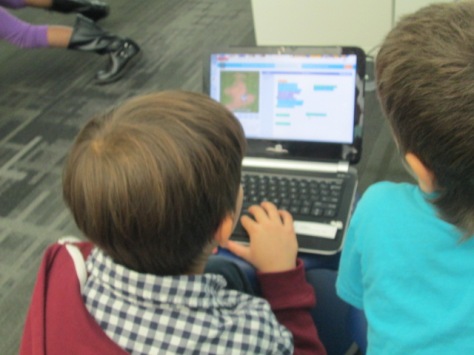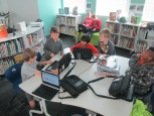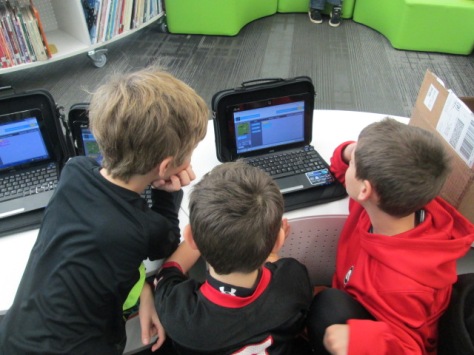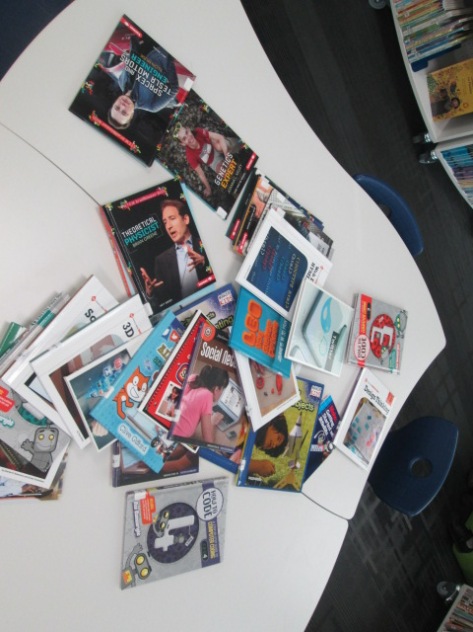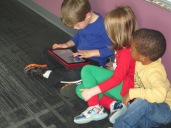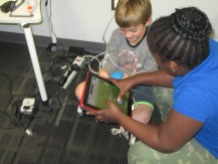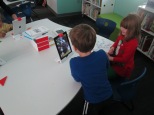
For the past 3 years, our library has participated in Hour of Code during Computer Science in Education Week. This movement of setting aside an hour to tinker with coding was started by Hadi Partovi. When we started back in 2014, there was only a handful of options of coding resources for students to try on code.org and many of them crashed due to the number of students using the site around the world. Fast forward to 2016 and students now have 172 reliable options in the Hour of Code portion of code.org and numerous other lessons that take them beyond the hour of code.

When we first started participating, classes came to the library to try out an hour of code. This year, many classes still came, but some classrooms also tried out the hour in their own rooms. It was fun to see something that started in the library spread into general classrooms.

This year we had classes from every grade participate in Hour of Code in the library (including PreK next week). We started each session by exploring the word “code” and connecting it to our own experiences. Many students talked about passcodes on phones or tablets. We then related this to the language that a computer speaks.
I had students think about their favorite video game or app and explained that every tap or press of a button was coded with instructions for the computer to know what to do. I also had students imagine if their favorite game or app never existed. What if the coders gave up while developing the game? This question brought the most gasps. We talked about the importance of mindset and not giving up. I loved that code.org had this great video that setup the idea of a growth mindset.
This year, I let students have a lot of choice in grades 3-5 because many of them had experienced hour of code or a coding project before. Some needed to try something more advanced while others needed to start with the basics. My big rule was that once they chose a coding activity, they were supposed to stick with it. With 172 options, it would be really easy to jump from one thing to another without really pushing yourself through the hard parts. I loved that code.org had a filter to filter by grade level or coding experience.
For grades K-2, we used an app on the iPad called Box Island, but we also had the flexibility to move to code.org if students were ready to move on to something else. I thought it was easier to stick with one tool for these grade levels since coding was so new to most of the students.
Students worked on coding all over the library. Some grouped themselves on cushions or tables. Others worked alone. Collaboration between students started to happen whether they were using the same app or something different. It’s something I see in makerspace as well. There’s something about this kind of experience that facilitates natural collaboration. Students want to help one another. It isn’t forced or required. It just happens.
Students persevere. They celebrate their success enthusiastically, and sometimes yell when something doesn’t work right.
It isn’t always perfect, though. Sometimes students give up. They say it’s too hard. Those moments are frustrating for me, but I like to talk with students about why they gave up. I can’t pretend that I don’t ever give up either…because I do. However, I think it’s important for us to acknowledge the importance of persevering even when things are hard because it’s a goal we should strive for.

At the end of each session, I brought students back together to talk about the experience. They started to crowdsource a list of tips to pass on to the class that came after them. Looking at their list you will see so many tips that could be applied to multiple situations, not just coding.
We also looked at subject areas like reading, writing, math, science, and social studies. I asked students to consider whether or not they used any of these subjects or skills while coding. They of course gave brilliant responses.
- Reading code is like reading another language
- We read instructions to know what to do
- I revised my code just like I revise my writing
- I had to use strategy just like solving a math problem
I invited them to think about how we might continue to explore coding as we create projects in class. Many of the students went home excited about coding and shared with families. I got messages from family members about their child’s eagerness to code. I even got a few pictures of coders in action while at home.
I love doing hour of code in the library because it’s a source of professional learning for teachers and a chance for students to try something they enjoy. We can take a risk together trying something new and then explore how to connect this with what we are already doing. Teachers see how engaged the students are and ponder how to continue that engagement. It’s also a very public space, so anyone who walks into our library during hour of code also starts to consider the power of coding in school. I’m still figuring out how we can weave this into more of our year. The students love it. They are engaged. How can we use this excitement to connect to what we are learning together each day?





















